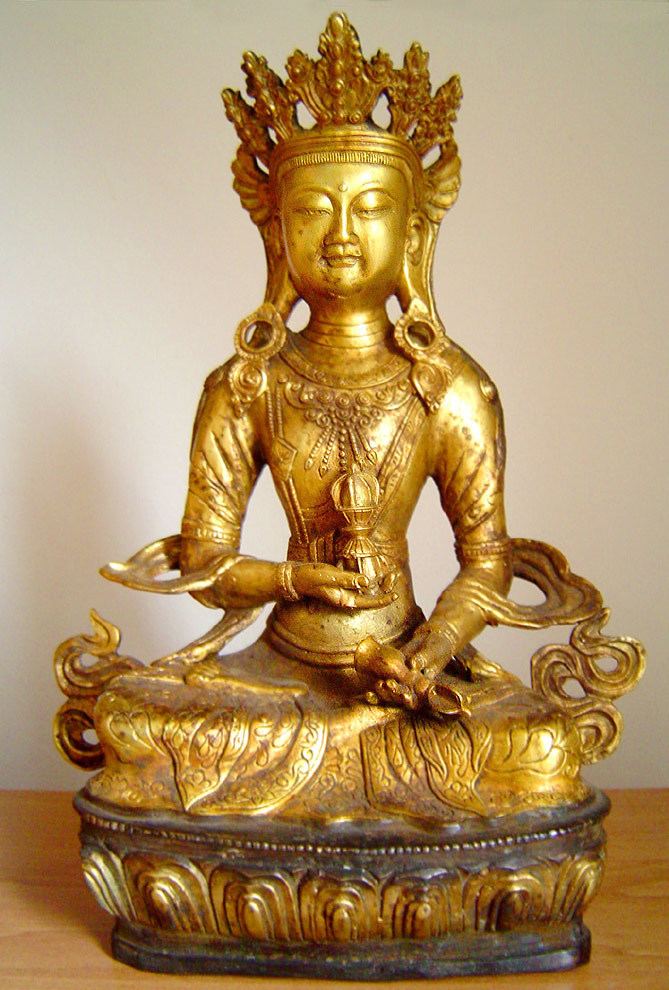 | ||
Vajrasattva (Sanskrit: वज्रसत्त्व, Tibetan: རྡོ་རྗེ་སེམས་དཔའ། Dorje Sempa, short form is རྡོར་སེམས། Dorsem, Монгол: Доржсэмбэ) is a bodhisattva in the Mahayana, Mantrayana/Vajrayana Buddhist traditions. In the Japanese Vajrayana school of Buddhism, Shingon, Vajrasattva is the esoteric aspect of the bodhisattva Samantabhadra and is commonly associated with the student practitioner who through the master's teachings, attains an ever-enriching subtle and rarefied grounding in their esoteric practice. In Tibetan Buddhism Vajrasattva is associated with the sambhogakāya and purification practice.
Contents
- Nomenclature orthography and etymology
- Newar Buddhism
- Shingon Buddhism
- Tibetan Buddhism
- Hundred Syllable Mantra
- Longchen Nyingtig
- Dzogchen
- Consorts
- References
Vajrasattva appears principally in two Buddhists texts: the Mahavairocana Sutra and the Vajrasekhara Sutra. In the Diamond Realm Mandala, Vajrasattva sits to the East near Akshobhya Buddha.
In some esoteric lineages, Nagarjuna was said to have met Vajrasattva in an iron tower in South India, and was taught tantra, thus transmitting the esoteric teachings to more historical figures.
Mantra = । ॐ वज्रसत्त्व हूं॥ oṁ vajrasattva hūṁ
Nomenclature, orthography and etymology
Vajrasattva' (Standard Tibetan: Dorje Sempa, short form dorsem, Japanese: Kongōsatta, Chinese: 金剛薩埵 Jīn gāng sà duǒ) is a bodhisattva in the Mahayana and Vajrayana buddhist traditions. Vajrasattva's name translates to Diamond Being or Thunderbolt Being, or, more appropriately considering that the term "vajra" often functions as a marker for tantric Buddhism, the Tantric Buddhist Being.
Newar Buddhism
Vajrasattva is an important figure in the tantric Buddhism of the Newar Vajrācāryas of the Kathmandu Valley. He represents the ideal guru, and he is frequently invoked in the guru maṇḍala, the foundational ritual for all other Newar Buddhist rituals and the daily pūjā for Newar priests. The śatākṣara (100 syllable prayer to Vajrasattva) is memorized early in life by most practicing Newar Buddhists.
Shingon Buddhism
In the Shingon Buddhist lineage, Vajrasattva is traditionally viewed as the second patriarch, the first being Vairocana Buddha himself. According to Kukai's writings in Record of the Dharma Transmission he relates a story based on Amoghavajra's account that Nagarjuna met Vajrasattva in an iron tower in southern India. Vajrasattva initiated Nagarjuna into the abhiseka ritual and entrusted him with the esoteric he had learned from Vairocana Buddha, as depicted in the Mahavairocana Sutra. Kukai does not elaborate further on Vajrasattva or his origins.
Elsewhere, Vajrasattva is an important figure in two esoteric Buddhist sutras, the Mahavairocana Sutra and the Vajrasekhara Sutra. In the first chapter of the Mahavairocana Sutra, Vajrasattva leads a host of beings who visit Vairocana Buddha to learn the Dharma. Vajrasattva inquires about the cause, goal and foundation of all-embracing wisdom, which leads to a philosophical discourse by the Buddha. The audience cannot comprehend the teaching, so the Buddha demonstrates through the use mandala. Vajrasattva then questions why rituals and objects are needed if the truth is beyond form. Vairocana Buddha replies to Vajrasattva that these are expedient means to bring practitioners to experience awakening more readily, and so on. In Shingon Buddhist rituals for initiation, the kechien kanjō, the initiate re-enacts the role of Vajrasattva and recites mantra and dialogue from the sutras above. The Maha Acharya enacts the role of Mahavairocana Buddha bestowing wisdom upon the student.
Tibetan Buddhism
In Tibetan Buddhism the Vajrasattva root tantra is Dorje Gyan, or "Vajra Ornament". Vajrasattva practices are common to all of the four schools of Tibetan Buddhism and are used both to purify obscurations so that the Vajrayana student can progress beyond Ngondro practices to the various yoga practices of tantra and also to purify any broken samaya vows after initiation. As such, Vajrasattva practice is an essential element of Tibetan Buddhist practice.
In addition to personal practice, the Vajrasattva mantra is regarded as having the ability to purify karma, bring peace, and cause enlightened activity in general. Following the September 11, 2001 attacks on the United States, The Dzogchen Ponlop Rinpoche announced a project, Prayer 4 Peace, to accumulate one billion six syllable Vajrasattva recitations by practitioners around the world. The six syllable mantra (oṁ vajrasattva hūṁ ), is a less formal version of the one hundred syllable mantra on which it is based but contains the essential spiritual points of the longer mantra, according to lama and tulku Jamgon Kongtrul.
Hundred Syllable Mantra
In Tibetan Vajrayana Buddhist practice, Vajrasattva is used in the Ngondro, or preliminary practices, in order to purify the mind's defilements, prior to undertaking more advanced tantric techniques. The yik gya, the "Hundred Syllable Mantra" (Tibetan: ཡིག་བརྒྱ, Wylie: yig brgya) supplication of Vajrasattva, approaches universality in the various elementary Ngondro sadhana for sadhakas of all Mantrayana and Sarma schools bar the Bonpo. The pronunciation and orthography differ between lineages.
Longchen Nyingtig
The evocation of the Hundred Syllable Vajrasattva Mantra in the Vajrayana lineage of Jigme Lingpa's (1729–1798) ngondro from the Longchen Nyingtig displays Sanskrit-Tibetan hybridization. Such textual and dialectical diglossia (Sanskrit: dvaibhashika) is evident from the earliest transmission of tantra into the region, where the original Sanskrit phonemes and lexical items are often orthographically rendered in the Tibetan, rather than the comparable indigenous terms (Davidson, 2002). Though Jigme Lingpa did not compose the Hundred Syllable Mantra, his scribal style bears a marked similarity to it as evidenced by his biographies (Gyatso, 1998). Jigme Lingpa as pandit, which in the Himalayan context denotes an indigenous Tibetan versed in Sanskrit, often wrote in a hybridized Sanskrit-Tibetan diglossia.
Dzogchen
"The Mirror of the Heart of Vajrasattva" (Tibetan: རྡོ་རྗེ་སེམས་དཔའ་སྙིང་གི་མེ་ལོང, Wylie: rdo rje sems dpa' snying gi me long) is one of the Seventeen Tantras of Dzogchen Upadesha.
Samantabhadra discourses to Vajrasattva and in turn Vajrasattva asks questions of Samantabhadra in clarification in the Kulayaraja Tantra (Wyl. kun byed rgyal po; Tib. künjé gyalpo) or "The All-Creating King Tantra", the main tantra of the Mind Series of Dzogchen.
Consorts
Vajrasattva is often depicted with various consorts, the peaceful one Vajragarvi aka Vajrasattvātmikā (Tib. Dorje Nyema), Dharmadhatvishvari, Ghantapani ("Bell Bearer"), the wrathful one Diptacakra, Vajratopa, Vajrabhrikuti, and others.
